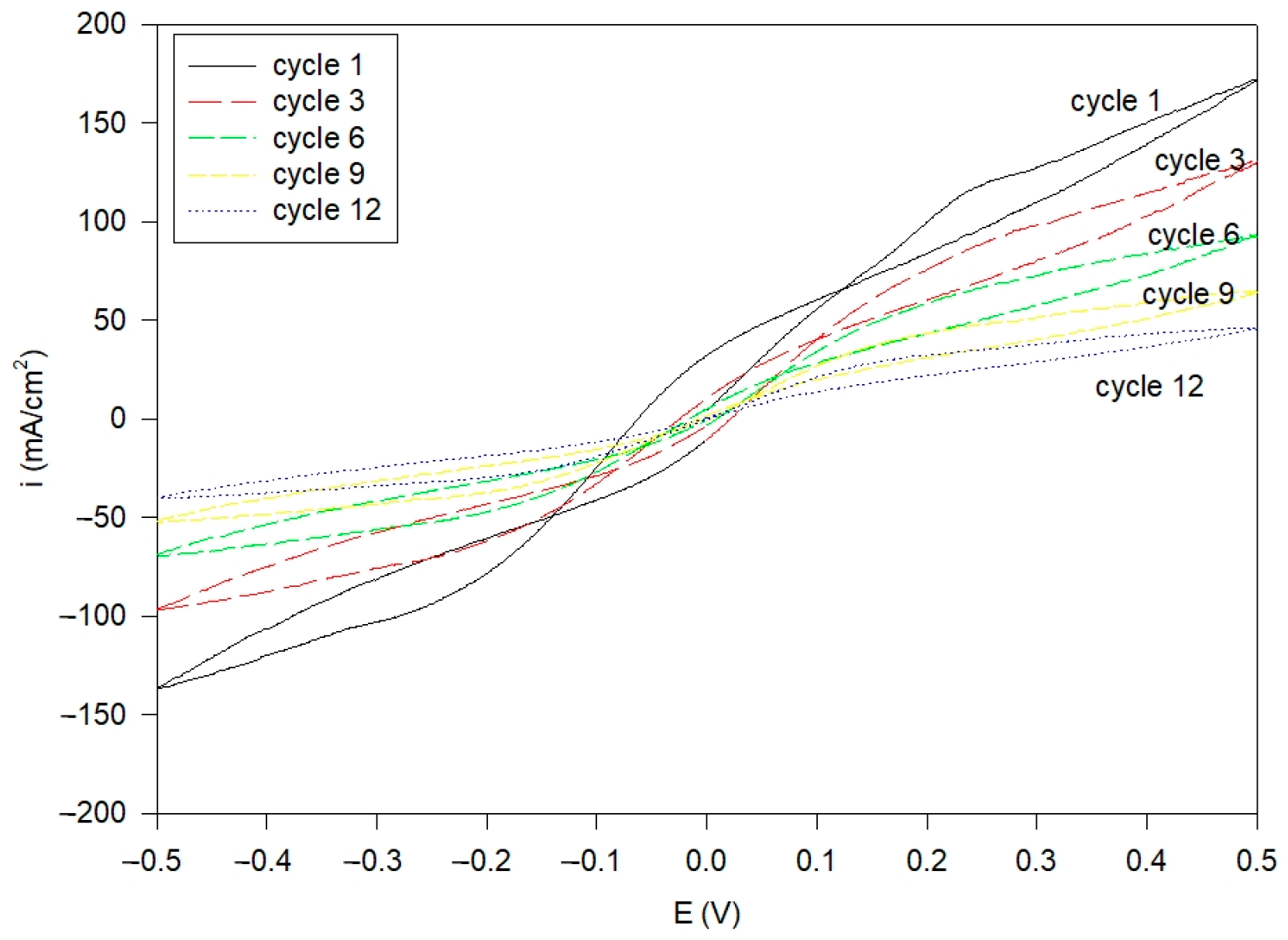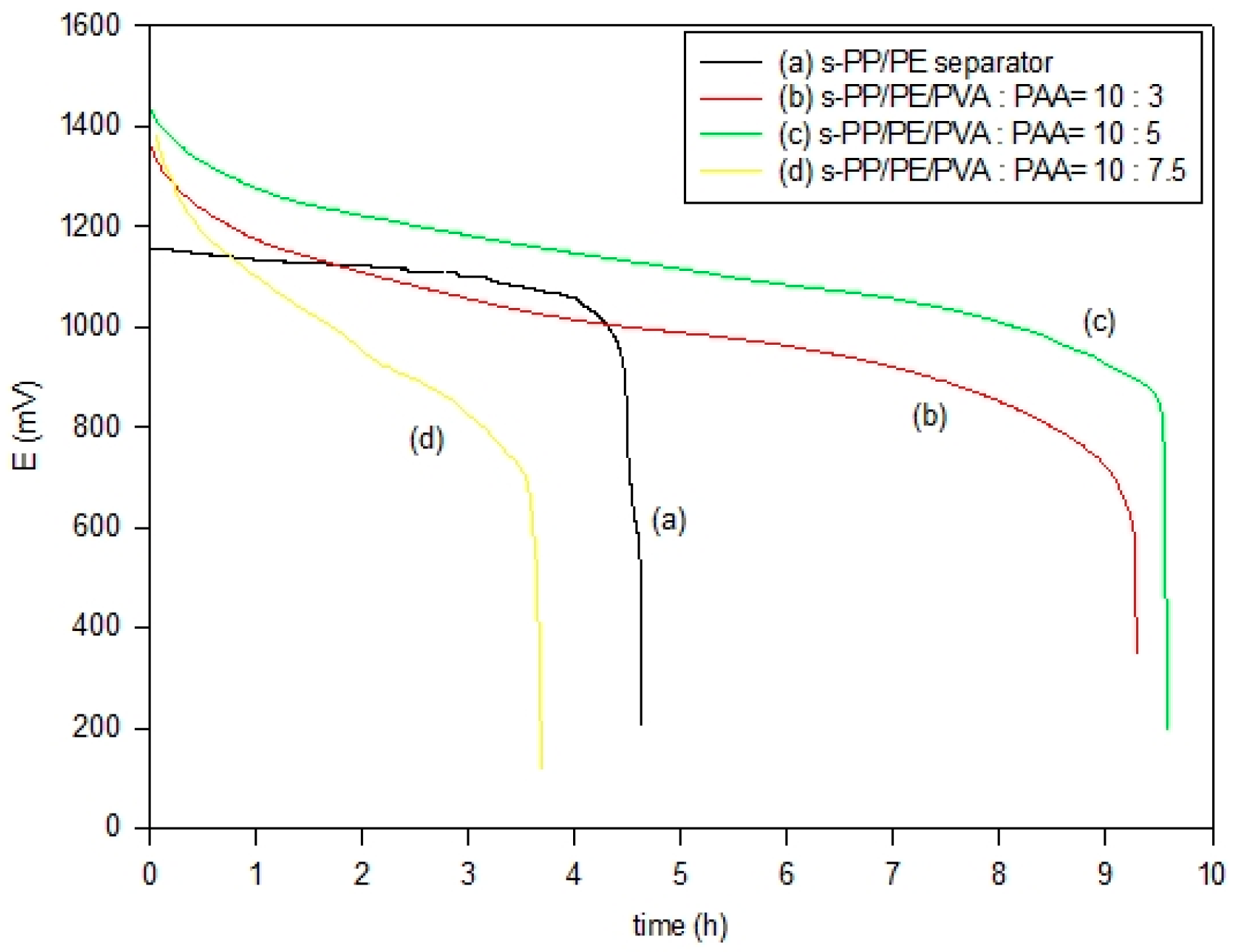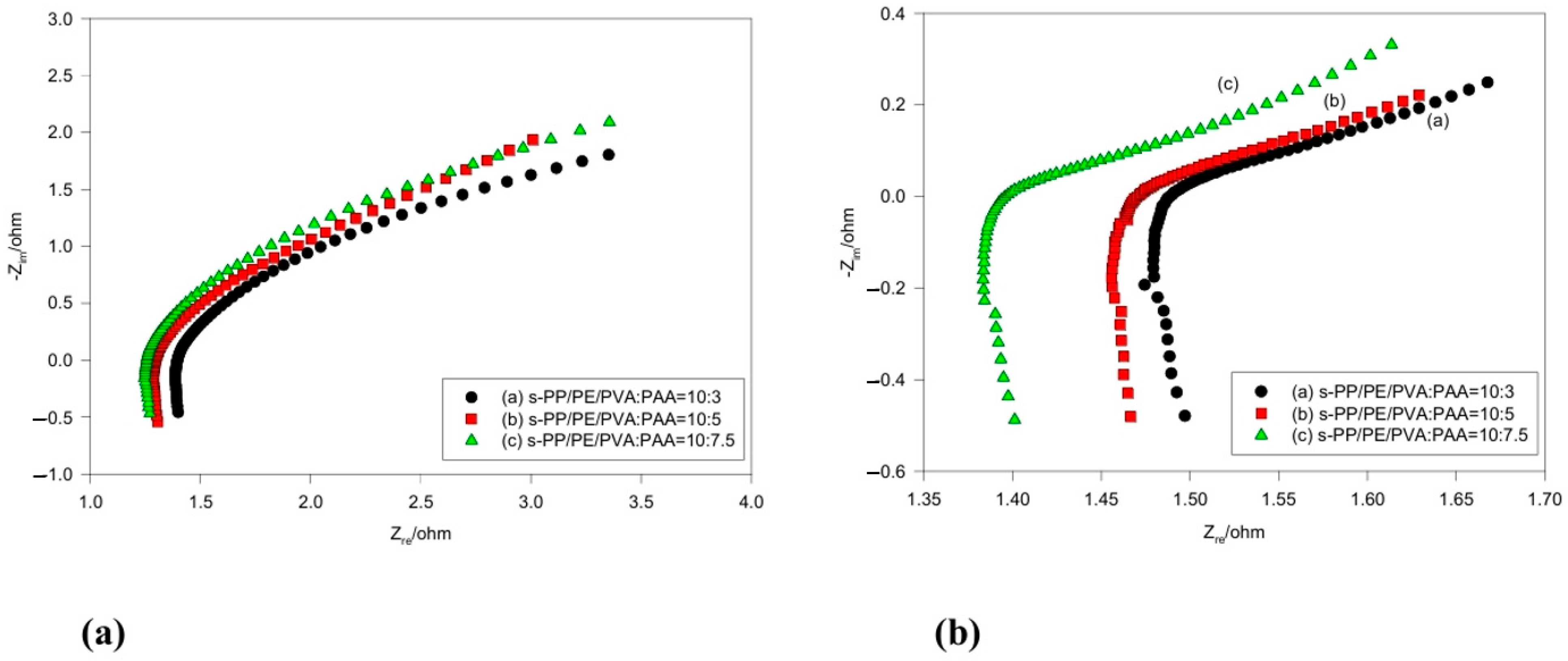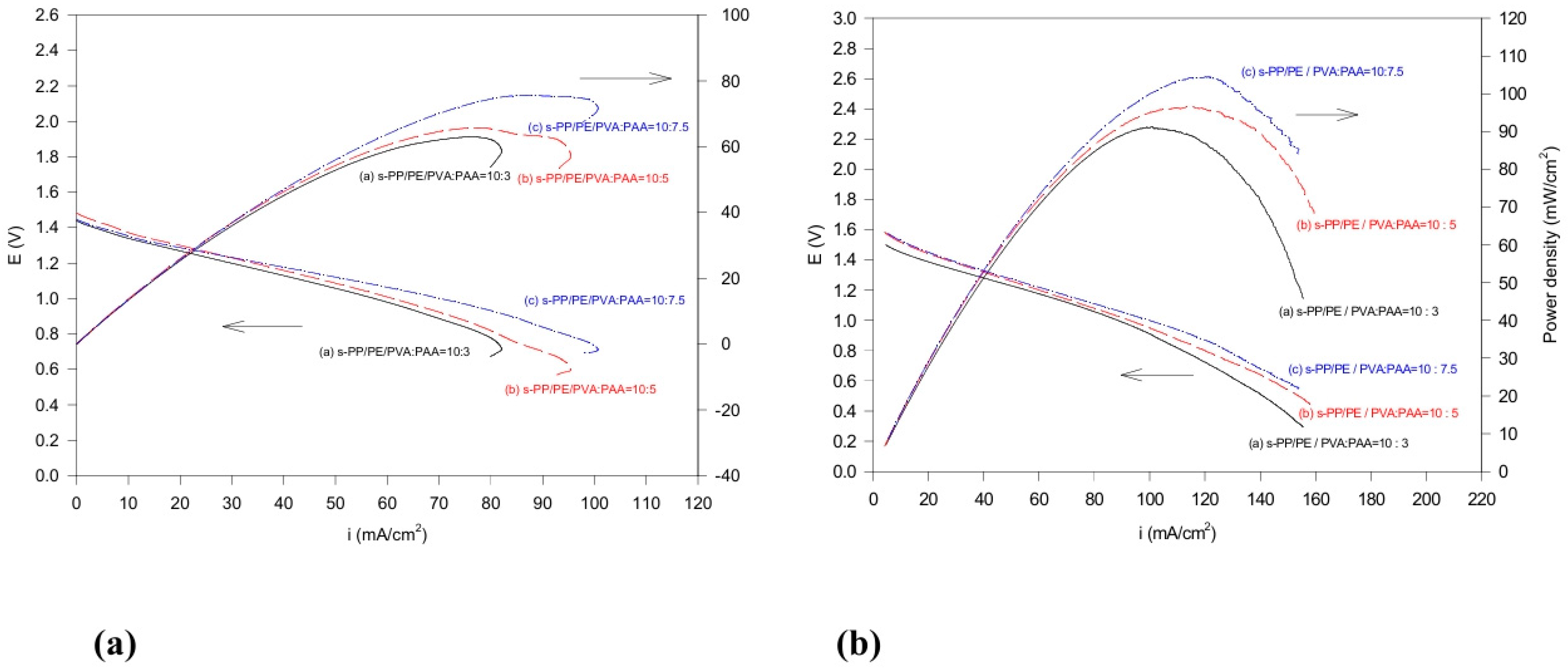Development of Polymer Composite Membrane Electrolytes in Alkaline Zn/MnO2, Al/MnO2, Zinc/Air, and Al/Air Electrochemical Cells
Abstract
1. Introduction
2. Materials and Methods
3. Results and Discussion
3.1. Morphology and Mechanical Properties
3.2. Swelling and Absorption
3.3. Ionic Conductivity
3.4. Cyclic Voltammetry Analysis
3.5. Electrochemical Performance of Solid Cells
4. Conclusions
Author Contributions
Funding
Institutional Review Board Statement
Data Availability Statement
Acknowledgments
Conflicts of Interest
References
- Zhao, T.; Yang, J.; Cai, L.; Zhu, W.; Wu, X.; Shao, L. Enhancing the performance of poly(ethylene oxide) solid electrolytes through synergistic interaction of starch and butanedinitrile. J. Appl. Polym. Sci. 2024, 141, 25. [Google Scholar] [CrossRef]
- Jithunsa, M.; Tashiro, K.; Nunes, S.P.; Chirachanchai, S. Poly(acrylic acid-co-4-vinylimidazole)/sulfonated poly(ether ether ketone) blend membranes: A role of polymer chain with proton acceptor and donor for enhancing proton transfer in anhydrous system. Int. J. Hydrogen Energy 2011, 36, 10384. [Google Scholar] [CrossRef]
- Molaiyan, P.; Valikangas, J.; Sliz, R.; Ramteke, D.D.; Hu, T.; Paolella, A.; Fabritius, T.; Lassi, U. Screen-printed composite LiFePO4-LLZO cathodes towards solid-state Li-ion batteries. ChemElectroChem 2024, 11, 9. [Google Scholar] [CrossRef]
- Sashmitha, K.; Rani, M.U. A comprehensive review of polymer electrolyte for lithium-ion battery. Polym. Bull. 2023, 80, 89–135. [Google Scholar] [CrossRef]
- Fujiwara, F.; Yao, M.; Siroma, Z.; Senoh, H.; Ioroi, T.; Yasuda, K. Reversible air electrodes integrated with an anion-exchange membrane for secondary air batteries. J. Power Sources 2011, 196, 808–813. [Google Scholar] [CrossRef]
- Cruz-Balaz, M.I.; Bosquez-Caceres, M.F.; Delgado, A.D.; Arjona, N.; Morera Cordova, V.; Alvarez-Contreras, L.; Tafur, J.P. Green energy storage: Chitosan-avocado starch hydrogels for a novel generation of zinc battery electrolytes. Polymers 2023, 15, 4398. [Google Scholar] [CrossRef]
- Xie, C.; Yang, R.; Wan, X.; Li, H.; Ge, L.; Li, X.; Zhao, G. A high proton conductivity all-biomass proton exchange membrane enabled by adenine and thymine modiffed cellulose nanoffbers. Polymers 2024, 16, 1060. [Google Scholar] [CrossRef]
- Kwon, N.H.; Lee, K.G.; Kim, H.K.; Hwang, S.J. MnO2-based nanostructured materials for various energy applications. Mater. Chem. Front. 2021, 5, 3549–3575. [Google Scholar] [CrossRef]
- Jia, S.; Li, L.; Shi, Y.; Wang, C.; Cao, M.; Ji, Y.; Zhang, D. Recent development of manganese dioxide-based materials as zinc-ion battery cathode. Nanoscale 2024, 16, 1539–1576. [Google Scholar] [CrossRef]
- Wu, G.M.; Lin, S.J.; Yang, C.C. High performance composite solid polymer electrolyte systems for electrochemical cells. J. Power Sources 2013, 244, 287–293. [Google Scholar] [CrossRef]
- Gao, M.; Song, Y.; Zou, X.; Salla, M.; Zhang, H.; Wang, Z.; Huang, S.; Wang, Q. A redox-mediated iron-air fuel cell for sustainable and scalable power generation. Adv. Energy Mater. 2023, 13, 2301868. [Google Scholar] [CrossRef]
- Jia, P.; Zhang, J.; Xia, G.; Yu, Z.; Sun, J.; Ji, X. 2D zinc-based metal–organic complexes derived N-doped porous carbon nanosheets as durable air cathode for rechargeable Zn–air batteries. Polymers 2022, 14, 2581. [Google Scholar] [CrossRef] [PubMed]
- Zhang, H.; Huang, S.; Salla, M.; Zhuang, J.; Gao, M.; Lek, D.G.; Ye, H.; Wang, Q. A redox-mediated zinc-air fuel cell. ACS Energy Lett. 2022, 7, 2565–2575. [Google Scholar] [CrossRef]
- Song, Y.; Xia, L.; Salla, M.; Xi, S.; Fu, W.; Wang, W.; Gao, M.; Huang, S.; Huang, S.; Wang, X.; et al. A hybrid redox-mediated zinc-air fuel cell for scalable and sustained power generation. Angew. Chem. Int. Ed. 2024, 63, e202314796. [Google Scholar] [CrossRef]
- Zhou, D.; Shanmukaraj, D.; Tkacheva, A.; Armand, M.; Wang, G. Polymer electrolytes for lithium-based batteries: Advances and prospects. Chem 2019, 5, 2326–2352. [Google Scholar] [CrossRef]
- Cai, K.; Pu, W.; Gao, Y.; Hou, J.; Deng, C.; Wang, C.; Mao, Z. Investigation of ionic liquid composite electrolyte for lithium–oxygen battery. Int. J. Hydrogen Energy 2013, 38, 11023–11027. [Google Scholar] [CrossRef]
- Zhao, Y.; Wang, L.; Zhou, Y.; Liang, Z.; Tavajohi, N.; Li, B.; Li, T. Solid polymer electrolytes with high conductivity and transference number of Li ions for Li-based rechargeable batteries. Adv. Sci. 2021, 8, 2003675. [Google Scholar] [CrossRef]
- Barbosa, J.C.; Goncalves, R.; Costa, C.M.; Lanceros-Mendez, S. Toward sustainable solid polymer electrolytes for lithium-ion batteries. ACS Omega 2022, 7, 14457–14464. [Google Scholar] [CrossRef]
- Kumar, S.; Raghupathy, R.; Vittadello, M. Sodium polymer electrolytes: A review. Batteries 2024, 10, 73. [Google Scholar] [CrossRef]
- Choudhury, S.; Stalin, S.; Vu, D.; Warren, A.; Deng, Y.; Biswal, P.; Archer, L.A. Solid-state polymer electrolytes for high performance lithium metal batteries. Nat. Commun. 2019, 10, 4398. [Google Scholar] [CrossRef]
- Song, Z.; Chen, F.; Martinez-Ibanez, M.; Feng, W.; Forsyth, M.; Zhou, Z.; Armand, M.; Zhang, H. A reflection on polymer electrolytes for solid-state lithium metal batteries. Nat. Commun. 2023, 14, 4884. [Google Scholar] [CrossRef] [PubMed]
- Fenton, D.E.; Parker, J.M.; Wright, P.V. Complexes of alkali metal ions with poly (ethylene oxide). Polymer 1973, 14, 589. [Google Scholar] [CrossRef]
- Armand, M.B.; Chabagno, J.M.; Duclot, M.J. Fast Ion Transport in Solids; Vashishta, P., Mundy, J.N., Shenoy, G.K., Eds.; Elsevier: Amsterdam, The Netherlands, 1979; pp. 131–136. [Google Scholar]
- Fauvarque, J.F.; Guinot, S.; Bouzir, N.; Salmon, E.; Penneau, J.F. Alkaline poly(ethylene oxide) solid polymer electrolytes. Application to nickel secondary batteries. Electrochim. Acta 1995, 40, 2449–2453. [Google Scholar] [CrossRef]
- Guinot, S.; Salmon, E.; Penneau, J.F.; Fauvarque, J.F. A new class of PEO-based SPEs: Structure, conductivity and application to alkaline secondary batteries. Electrochim. Acta 1998, 43, 1163–1170. [Google Scholar] [CrossRef]
- Lokkiluoto, A.; Gasik, M.M. Modeling and experimental assessment of Nafion membrane properties used in SO2 depolarized water electrolysis for hydrogen production. Int. J. Hydrogen Energy 2013, 38, 10–19. [Google Scholar] [CrossRef]
- Sasikumar, G.; Ihm, J.W.; Ryu, H. Optimum Nafion content in PEM fuel cell electrodes. Electrochim. Acta 2004, 50, 598. [Google Scholar] [CrossRef]
- Liew, C.W.; Ramesh, S.; Arof, A.K. Good prospect of ionic liquid based-poly(vinyl alcohol) polymer electrolytes for supercapacitors with excellent electrical, electrochemical and thermal properties. Int. J. Hydrogen Energy 2014, 39, 2953–2963. [Google Scholar] [CrossRef]
- Merle, G.; Hosseiny, S.S.; Wessling, M.; Nijmeijer, K. New cross-linked PVA based polymer electrolyte membranes for alkaline fuel cells. J. Membr. Sci. 2012, 409, 191–199. [Google Scholar] [CrossRef]
- Shamchi, S.; Farahani, B.V.; Bulla, M.; Kolling, S. Mechanical behavior of lithium-ion battery separators under uniaxial and biaxial loading conditions. Polymers 2024, 16, 1174. [Google Scholar] [CrossRef]
- Wu, G.M.; Lin, S.J.; Yang, C.C. Alkaline Zn-air and Al-air cells based on novel solid PVA/PAA polymer electrolyte membranes. J. Membr. Sci. 2006, 280, 802. [Google Scholar] [CrossRef]
- Othman, R.; Yahaya, A.H.; Arof, A.K. A zinc-air cell employing a porous zinc electrode fabricated from zinc-graphite-natural biodegradable polymer paste. J. Appl. Electrochem. 2002, 32, 1347–1353. [Google Scholar] [CrossRef]










| Property | s-PP/PE/PVA–PAA (10:3) | s-PP/PE/PVA–PAA (10:5) | s-PP/PE/PVA–PAA (10:7.5) |
|---|---|---|---|
| Swelling ratio (%) | 52.6 | 58.1 | 61.3 |
| Absorption ratio (%) | 110.9 | 138.1 | 154.7 |
| Temperature (°C) | s-PP/PE/PVA–PAA (10:3) | s-PP/PE/PVA–PAA (10:5) | s-PP/PE/PVA–PAA (10:7.5) |
|---|---|---|---|
| 25 | 0.090 | 0.157 | 0.210 |
| 40 | 0.093 | 0.166 | 0.232 |
| 50 | 0.096 | 0.177 | 0.246 |
| 60 | 0.100 | 0.183 | 0.265 |
| 70 | 0.101 | 0.194 | 0.279 |
| 80 | 0.109 | 0.202 | 0.291 |
| Property | s-PP/PE/PVA–PAA (10:3) | s-PP/PE/PVA–PAA (10:5) | s-PP/PE/PVA–PAA (10:7.5) |
|---|---|---|---|
| Design capacity (mAh) | 1574 | 1574 | 1574 |
| Discharge current (mA) | 150 | 150 | 150 |
| Discharge time (h) | 9.3 | 9.5 | 3.6 |
| Real capacity (mAh) | 1465 | 1507 | 581 |
| Utilization (%) | 93.1 | 95.7 | 37.0 |
| Cell bulk resistance before discharge (Ω) | 1.39 | 1.31 | 1.27 |
| Cell bulk resistance after discharge (Ω) | 1.49 | 1.47 | 1.40 |
Disclaimer/Publisher’s Note: The statements, opinions and data contained in all publications are solely those of the individual author(s) and contributor(s) and not of MDPI and/or the editor(s). MDPI and/or the editor(s) disclaim responsibility for any injury to people or property resulting from any ideas, methods, instructions or products referred to in the content. |
© 2024 by the authors. Licensee MDPI, Basel, Switzerland. This article is an open access article distributed under the terms and conditions of the Creative Commons Attribution (CC BY) license (https://creativecommons.org/licenses/by/4.0/).
Share and Cite
Lin, S.-J.; Su, J.-Y.; Chen, D.W.; Wu, G. Development of Polymer Composite Membrane Electrolytes in Alkaline Zn/MnO2, Al/MnO2, Zinc/Air, and Al/Air Electrochemical Cells. Polymers 2024, 16, 3068. https://doi.org/10.3390/polym16213068
Lin S-J, Su J-Y, Chen DW, Wu G. Development of Polymer Composite Membrane Electrolytes in Alkaline Zn/MnO2, Al/MnO2, Zinc/Air, and Al/Air Electrochemical Cells. Polymers. 2024; 16(21):3068. https://doi.org/10.3390/polym16213068
Chicago/Turabian StyleLin, Sheng-Jen, Juin-Yih Su, Dave W. Chen, and Gwomei Wu. 2024. "Development of Polymer Composite Membrane Electrolytes in Alkaline Zn/MnO2, Al/MnO2, Zinc/Air, and Al/Air Electrochemical Cells" Polymers 16, no. 21: 3068. https://doi.org/10.3390/polym16213068
APA StyleLin, S.-J., Su, J.-Y., Chen, D. W., & Wu, G. (2024). Development of Polymer Composite Membrane Electrolytes in Alkaline Zn/MnO2, Al/MnO2, Zinc/Air, and Al/Air Electrochemical Cells. Polymers, 16(21), 3068. https://doi.org/10.3390/polym16213068







